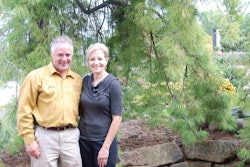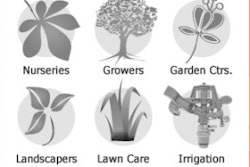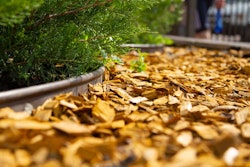By Dr. A. D. Ali and Dr. Christopher J. Luley
Plants in urban landscapes suffer from a variety of stress factors. The majority of those are human-induced, while a smaller portion is caused by biotic agents such as insects and disease-causing pathogens. However, many clients and practitioners believe that pests are responsible for most landscape problems.
Poor cultural practices are likely the most common causes of stress. Among these are soil-related factors such as compaction, high alkalinity or pH imbalance and lack of nutrients. Compaction is the physical destruction of soil structure which literally squeezes air and water from among soil particles. The lack of soil oxygen results in poor root development. High alkalinity or an imbalance in the pH results in micronutrient deficiencies such as iron or manganese. Plants display this in the form of yellowing of foliage or chlorosis. Most urban soils are low in organic matter and nutrients. Eager homeowners tend to worsen the problem by applying excessive amounts of fertilizers with the premise of ‘the more the better.’ This increases salt concentrations in the soil and desiccates the plants in a condition termed fertilizer burn.
Other examples of human-induced urban stresses include improper planting, mulching and watering. Planting too deeply reduces the amount of oxygen available to the roots which causes decline. Excessive mulching also reduces the amounts of water and nutrients reaching the root zone; whereas insufficient mulching results in drying of the soil and damage to fine roots. Too much water will result in anaerobic, water-logged conditions which cause death of the roots through asphyxia and may cause infection by soil-borne pathogens such as the water mold Phytophthora. The pH of the irrigation water also should be monitored to prevent build-up in soil alkalinity.
Selecting the right location for a particular plant is often overlooked. Examples abound in any city where trees are planted adjacent to paved surfaces or hardscapes which limits the root zone. As the tree matures, roots interfere with and may damage the surrounding hardscapes. The unfortunate solution is severing roots in order to repair the damaged sidewalks. Mechanical damage to the bark with equipment such as mowers or weed whackers also is common in urban landscapes. The long-term impacts of such damage may lead to root and trunk decay and result in a tree with a high risk of failure.
Insects and disease causing agents may also lead to plant stress in urban landscapes. Pests such as the Japanese beetle or gypsy moth can cause harm through extensive defoliation. Pathogens such as anthracnose may also cause significant leaf drop. In most cases, unless the damage is severe, pests do not irreparably harm landscape plants. Experience and research have shown that if practitioners are familiar with about a dozen of the most common pests in an area, they can identify the majority of insects that clients have questions about.
Many of the most serious insect and pathogen attacks occur after a plant has been weakened by other factors. For example, borers are usually attracted to trees weakened by construction damage. In addition, there are there are only a handful of destructive pests that can outright kill a healthy tree.
Understanding the cause of stress is the first step to maintaining healthy plants in the urban landscape. Correctly diagnosing the symptoms of stress requires knowledge of the various above- and below-ground abiotic and biotic agents that cause problems in the landscape. A recent book by the authors, “Pest Management in the Landscape: An Introduction,” provides a thorough understanding of such factors. Information in the book is presented both in text as well as color illustrations. The easy-to-read style is intended for landscape care providers, homeowners, Master Gardeners and anyone seeking a broad understanding of urban plant stress and how to manage it. The book is available from www.isa-arbor.com. Information for ordering large quantities can be found at www.urbanforestryllc.com.
About the authors: Dr. A. D. Ali is technical adviser with the Davey Institute, a division of the Davey Tree Expert Company, located in Alva, Florida, [email protected]. Dr. Christopher J. Luley is plant pathologist and consulting arborist with Urban Forestry in Naples, New York, [email protected].
Severed roots of a mature ash tree next to a newly repaired sidewalk.










